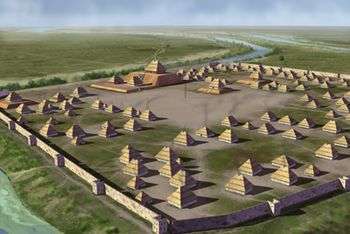Casqui

Casqui was a Native American tribe discovered in 1541 by the Hernando de Soto expedition. This tribe inhabited fortified villages in eastern Arkansas.
The tribe takes its name from the chieftain Casqui who ruled the tribe from its primary village thought to be located in present day Cross County, Arkansas near the town of Parkin. The suspected site is the focal point of the Parkin Archeological State Park and it has been determined that the site was continuously occupied for at least 500 years. Information about Chief Casqui and his people comes from journals made during the expedition of Hernando de Soto in 1541.
de Soto Expedition
When de Soto's expedition arrived in the area the Casqui walked over a mile from their village to greet the travelers and invite them to stay in the town. The travelers declined the offer and made camp outside of the village. The journals report that de Soto gave a speech to the Casqui about religion and baptized several of the villagers as Christians. The journals report that the villagers helped them erect a large wooden cross on the central mound.
When de Soto determined to press on and visit the nearby tribe called the Pacaha many of the Casqui people followed him. The Casqui and the Pacaha had been at war for some time and the Casqui had raided the Pacaha on previous occasions. When de Soto and the Casqui approached, many of the Pacaha became afraid and attempted to flee to an island in the river and drowned. The Casqui who had followed de Soto proceeded to sack the village, desecrate holy sites, and steal everything they could.

De Soto contacted Chief Pacaha and convinced him that he had nothing to do with the attack and that the expedition's intentions were peaceful. De Soto even assured the Pacaha that the expedition would help the Pacaha attack the Casqui to punish them for their subterfuge.
The Casqui received advance warning of the planned attack and returned the looted items to the Pacaha and issued an apology in order to stave off retribution. De Soto arranged a dinner for the two leaders and arranged a peace treaty between the tribes.
The Hernando de Soto expedition records are the only historical records of Chief Casqui and his tribe. Their later history is uncertain.
In recent years a Spanish trade bead which matches descriptions of the seven-layer glass beads carried by the expedition has been found at the Parkin site as well as two Spanish falconer's bells, and Spanish musket balls.[1][2]
Controversy
The accepted path of de Soto's travels was established by the research of the de Soto Commission in 1939 led by Dr. John R. Swanton and has been generally accepted by the United States government and most archaeologists as the actual route. Some detractors claim that de Soto instead travelled north into the states of Indiana and Illinois and found the Ohio River instead of the Mississippi River.
Due to this controversy some claim that the town of Pacaha was actually located on the present day site of Terre Haute, Indiana with the Casqui tribe living near present-day Vincennes, Indiana. This route is not the officially accepted route but archaeological study and analysis continues.
Other sites and personages encountered by the De Soto Expedition
- List of sites and peoples visited by the Hernando de Soto Expedition
- Pacaha
- Mississippian culture
- Southeastern Ceremonial Complex
References
- ↑ "THE PARKIN SITE:HERNANDO DE SOTO IN CROSS COUNTY, ARKANSAS" (PDF). Retrieved 2008-09-19.
- ↑ "Parkin Archeological State Park-Encyclopedia of Arkansas". Retrieved 2008-09-19.
External links
- University of Arkansas Report on de Soto travels in Arkansas
- National Park Service on de Soto's expedition
- European Explorers in Arkansas
- Website on alternate theory

